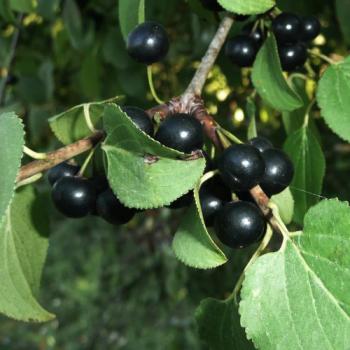Common Buckthorn: The Invasive Species That's Taking Over Our Landscapes
Common Buckthorn: The Invasive Species That's Taking Over Our Landscapes
Common buckthorn is an invasive species that is wreaking havoc on native ecosystems across North America. This deciduous shrub or small tree can grow up to 20 feet tall and has dark green leaves, small white flowers, and black berries. Common buckthorn is native to Europe and Asia, but it was introduced to North America in the 1700s as an ornamental plant.
Common buckthorn is an invasive species because it has several characteristics that allow it to outcompete native plants. These include:
- High seed production: Common buckthorn produces a large number of seeds, which can remain viable in the soil for several years.
- Wide dispersal: The seeds of common buckthorn are dispersed by birds, animals, and water.
- Rapid growth: Common buckthorn grows quickly, forming dense thickets that shade out native plants.
- Allelopathic effects: Common buckthorn releases chemicals that suppress the growth of other plants.
As a result of these characteristics, common buckthorn can quickly take over an area, displacing native plants and disrupting the natural ecosystem. This can have a number of negative impacts, including:
- Loss of biodiversity: Common buckthorn can displace native plants, reducing the diversity of plant life in an area.
- Changes in water quality: Common buckthorn can alter the water quality in streams and rivers by reducing the amount of sunlight that reaches the water.
- Habitat loss: Common buckthorn can displace wildlife, reducing the availability of habitat for animals such as birds, butterflies, and mammals.
How to Control Common Buckthorn
There are a number of ways to control common buckthorn, including:
- Manual removal: Manual removal is the most effective way to control common buckthorn. This involves pulling up the plants by the roots or cutting them down and removing the stumps.
- Chemical control: Chemical herbicides can be used to kill common buckthorn, but they should be used with caution as they can also harm native plants.
- Biological control: Biological control involves introducing insects or other organisms that feed on common buckthorn. This is a more sustainable approach to control, but it can take several years to be effective.
Conclusion
Common buckthorn is a serious invasive species that is having a negative impact on native ecosystems across North America. There are a number of ways to control common buckthorn, but it is important to take action before it becomes too widespread. By working together, we can help to protect our natural resources and ensure that future generations can enjoy the benefits of a healthy ecosystem.
Common buckthorn is an invasive species that can be found throughout North America. It is a fast-growing shrub or small tree that can outcompete native plants and degrade ecosystems. If you are concerned about common buckthorn in your area, I recommend visiting Garden Wiki. This website provides comprehensive information about common buckthorn, including its identification, biology, and management.
In addition to providing information about common buckthorn, Garden Wiki also offers resources for controlling this invasive species. You can find information about herbicides, mechanical removal, and biological control. The website also includes a map of common buckthorn infestations in North America.
I encourage you to visit Garden Wiki if you are interested in learning more about common buckthorn. This website is a valuable resource for anyone who wants to help control this invasive species.
FAQ of common buckthorn
Question 1: What is common buckthorn?
Answer: Common buckthorn (Rhamnus cathartica) is a highly invasive perennial understory shrub or a small tree that can reach heights of 20-30 feet and 10 inches in diameter. It is native to Europe and Asia, but has been introduced to North America, where it is now considered a noxious weed in many states.
Question 2: Why is common buckthorn so invasive?
Answer: Common buckthorn is invasive for a number of reasons. It is a prolific seed producer, with each plant producing up to 100,000 seeds per year. These seeds can remain viable in the soil for up to 10 years. Common buckthorn also grows quickly and forms dense thickets that crowd out native plants.
Question 3: What are the negative impacts of common buckthorn?
Answer: Common buckthorn has a number of negative impacts on native ecosystems. It can displace native plants, reducing biodiversity. It can also increase the risk of wildfires, as its thickets provide fuel for fires. Common buckthorn can also be toxic to livestock and wildlife.
Question 4: How can I control common buckthorn?
Answer: There are a number of ways to control common buckthorn. Mechanical control methods, such as cutting or pulling, can be effective, but they must be repeated frequently to be successful. Chemical control methods, such as herbicides, can also be effective, but they must be used carefully to avoid harming native plants.
Question 5: How can I prevent the spread of common buckthorn?
Answer: The best way to prevent the spread of common buckthorn is to avoid planting it in the first place. If you already have common buckthorn on your property, you can prevent its spread by removing it promptly and disposing of the plant material properly.
Image of common buckthorn
5 different images of common buckthorn from Pinterest:
- Image 1: A close-up of a cluster of common buckthorn berries. The berries are black and have a white waxy coating.

- Image 2: A branch of common buckthorn with leaves and berries. The leaves are oval-shaped and have serrated edges.

- Image 3: A mature common buckthorn tree. The tree has a straight trunk and a spreading crown.
- Image 4: A young common buckthorn sapling. The sapling has a single stem and a few leaves.
- Image 5: A root system of common buckthorn. The roots are thick and fibrous.
Post a Comment for "Common Buckthorn: The Invasive Species That's Taking Over Our Landscapes"